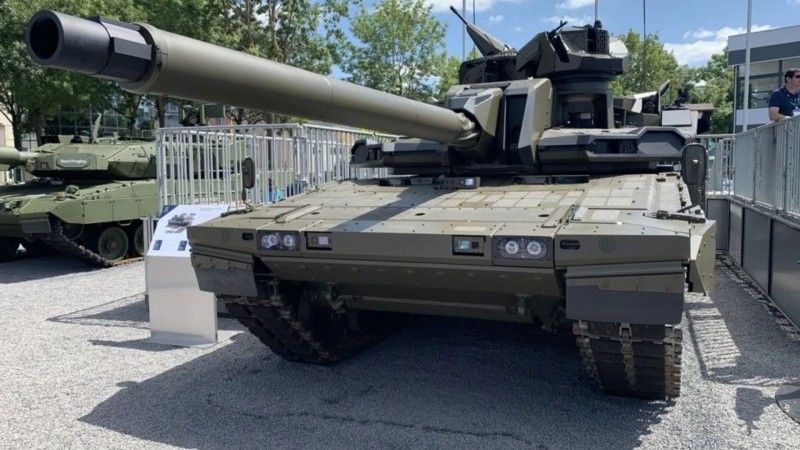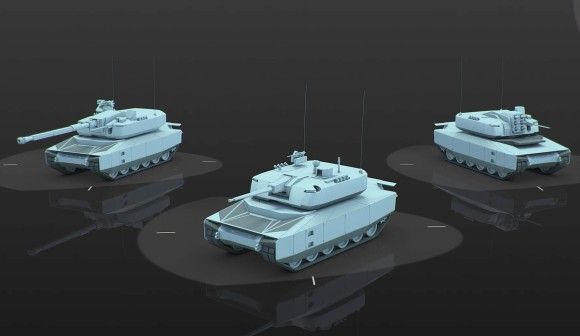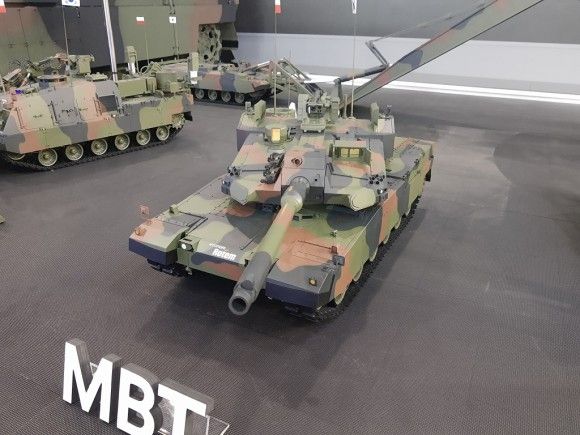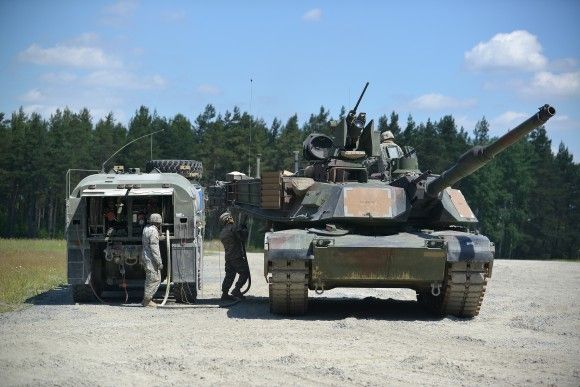Poland and European Future MBT. No Hope [OPINION]

These days, the argument is being made quite often, suggesting Poland shall join the European defence programmes aimed at acquiring new types of armour. Projects as such are worthy of scrutiny. One should also verify and consider the opinions circulated in the public sphere: should they be viewed as rational, or are they just wishful thinking?
Europanzer
To understand the challenges involved in projects as such, we need to go back in time. 1955 may be viewed as a starting point. Back then, the Federal Republic of Germany and France began the Europanzer programme, aimed at the development of a new, European main battle tank. The lack of heavy, thick armour was one of the key requirements - based on a belief that to stop a HEAT round SC jet, a classic, homogeneous steel armour would need to be absurdly thick and heavy. Instead, low vehicle weight was placed at the top of the list of requirements, which translated into higher mobility.
However, that observation was disconnected from reality. First, the Eastern Bloc armoured units used sabot AP rounds quite commonly. And this was a long-term trend. The armour-piercing fin-stabilized discarding sabot (APFSDS) rounds were far more common than shaped-charge rounds. For instance, in the 1980s, in the case of the commonly operated T-54 and T-55 main battle tank families (in the case of the Warsaw Pact), the most common anti-tank rounds included the BR-412 full bore projectile rounds, as opposed to sabot (3BM-20), or SC rounds (3BK-5M). Another erroneous conclusion came with a view suggesting that tactical mobility offers more effective protection than armour. The armoured vehicles will never be faster than a fired projectile.
The remainder of the Europanzer programme requirements were more rational, both when it came to firepower, accuracy, as well as maintenance requirements, tactical mobility, and ergonomics.
Back in 1957 Germany and France came to a final agreement on the requirements regarding the new main battle tank. Relevant documents were transferred to companies that were to work on the implementation of the undertaking. West Germany brought three Work Groups (Arbeitsgruppe, A, B, and C) to life. France established just a single group as such. In 1958 Italy also joined the Europanzer programme. Agreements on prototype development were signed during the very same year. In Germany, the A Group led by Porsche, and the B Group led by Rheinmetall were both assigned relevant contracts. The C team led by Borgward was eliminated.

Photo. Darkone/CC BY-SA 2.5
Meanwhile, cooperation with the AMX (Ateliers de construction d’Issy-les-Moulineaux) company was launched in France - also leading to a start of design works regarding a new MBT. Prototype test programmes began in 1961. The French MBT was being tested in Satory (Île-de-France), while the German prototypes underwent testing in Meppen (Lower Saxony). Back in 1963, the AMX prototype was tested in Germany. However, some obstacles began to emerge at that stage. First, the requirements defined by Germany started to become incoherent with what France was pursuing. The above pertained, primarily, to the main gun. The Germans went with the modified 105 mm L7 gun, provided by the UK. Meanwhile, the French were pushing towards using the French CN-105-F1 gun.
The L7 and CN-105-F1 guns use interchangeable 105x617 mm R ammunition (the US-made M68 gun also uses that round). The French, however, were also pushing towards using a SC round as the sole anti-tank munition. Furthermore, the French round with the OCC-105-F1 (Obus G) projectile is far more complicated than its US, German, or UK-made counterparts. It also requires a different rifling twist rate, to ensure optimal performance.

Photo. Rama/CC BY-SA 2.0 fr
The lack of an agreement in the main gun domain killed the Europanzer project. Germany and France decided to go separate ways, and work on their designs - Leopard 1 and AMX-30. As mentioned already, Italy was also a member of the initiative, however, the Italians did not make any significant technical contributions to the development of the prototypes. As the years went by, Rome ultimately obtained Leopard 1 manufacturing license for the OTO Melara facility.
Carro da Combattimento Leone
Italy was trying hard to gain more benefits for the domestic industry. Initially, the said plan took on the form of the Italian-German Carro da Combattimento Leone (Lion) programme. The goal was to develop a platform similar to Leopard 1, but cheaper, and exportable. The relevant consortium was established in 1975. Italian industry entities to participate included OTO Melara, Fiat, and Lancia, while Germany was represented by Krauss-Maffei, Blohm und Voss, Diehl, Jung-Porsche, MaK, and Luther-Werke.
The deal looked attractive, at least on paper. 50-50 split was implemented, when it came to the workload. Germany was working on the development and manufacturing of the hull, while the Italians were assigned the task of developing the turret. Interestingly, the turret was to be a welded one, similar to a solution known from Leopard 1A3, and A4 main battle tanks. The final assembly was to take place at the OTO Melara facility in La Spezia (Liguria). The plan was to develop a fully functional prototype by 1977 and to launch manufacturing a year later. From the technical point of view, the tank worked. It was based on numerous components that had been refined and manufactured long before it was born. Why is it, that no customers wanted to procure Leone?
First, for unspecified reasons, Leone was not pitched to potential buyers. Pakistan supposedly was the only party interested. The sources also mention some behind-the-scenes games regarding the price and the export rights. One may only guess, that Germany was the troublemaker here, being known for its very peculiar defence exports policy. Leone would also become a direct competitor of Leopard 1. Why would Germany share the profit 50-50 with Italy, when it could autonomously manufacture and export the Leopard 1? The license agreement regarding the Italian Leopard 1 manufacturing at OTO Melara explicitly prohibited any export efforts. This was not an exception - Germany used to commonly stop its partners from exporting jointly developed military equipment.
The Italians were trying to save the Leone project, by redesigning the hull to an extent that would stop the Germans from accusing them of breaching the Leopard 1 license agreement. This is how the OF-40 MBT was born - and it was not a spectacular success. Only 18 OF-40 Mk 1 and 18 OF-40 Mk 2 MBTs were built and exported to UAE. The Palmaria self-propelled howitzer, derived from OF-40, turned out to be much more successful. 235 vehicles were exported to Libya and Nigeria, and some turrets were sold to Argentina.
Kampfpanzer III/Napoléon I
Despite launching the production of AMX-30, France began to work on a replacement in 1964. 7 years later EPP (Engin Principal Prospectif) programme was launched, followed by Engin Futur in 1975.
France decided to ask Germany again, to launch a joint undertaking. The tank became known as Kampfpanzer III in Germany, and Napoléon I name was assigned to it in France. Protocol with arrangements was signed as early as 1980. However, similarly as in the case of the Europanzer programme, discrepancies emerged quickly, when it came to the requirements. In 1982 France and Germany decided to go separate ways again. France was continuing the development efforts within the framework of the EPC (Engin Principal de Combat) programme that, ultimately, led to the development of the Leclerc MBT.
Interestingly, West Germany was also involved in a joint MBT development programme with the US: MBT-70/KPz-70 (Main Battle Tank 70/Kampfpanzer 70). It was launched in 1963 but ended in a complete failure. USA and FRG decided to develop MBT designs of their own, nowadays known as M1 Abrams and Leopard 2.
FMBT-70
Back in the 1970s The UK was working on a new MBT concept - it was to replace the Chieftain MBT. The British government issued a request to the West Germans, asking for cooperation. The project was codenamed FMBT-70 (Future Main Battle Tank 70). MBT-80 designation is also commonly used, but it shall not be mistaken for another, British programme of the very same name.
FMBT-70 programme was launched in 1971. It started with the work groups meeting up, to formulate requirements for a new MBT, prepare a concept, conduct technical assessment, and also cost estimation. Attempts were being made to avoid problems that had been emerging during the previous programmes. Plan B assumed that the UK and West Germany would engage in parallel efforts aimed at developing new generation MBTs of their own.
Several designs were being considered, from 60 tonnes MBTs of conventional layout to turret-less designs weighing around 50 tonnes. The programme ended up in a fiasco. Back in 1977 head of the UK MoD, Frederick Mulley announced that the initiative was dissolved, due to major scheduling discrepancies, rendering the cooperation impractical, even though common requirements and tactical-technical assumptions were adopted.
Attempts were being made to recover the project as MBT-95 - but it never managed to leave the drawing board. The project did not result in the birth of a technology demonstrator, despite the use of numerous proven components developed for Leopard 2.
Third Time Lucky! Main Ground Combat System
„Those that fail to learn from history are doomed to repeat it”, Winston Churchill once said. This quote is still valid today. A similar scenario occurred in the case of French and German political elites who decided to launch the MGCS programme in 2017 (Main Ground Combat System). This is the third programme undertaken by those parties, aimed at developing an MBT.
One should note that not only does the MGCS assume that a new MBT would be developed, but the programme is aimed at the creation of a whole family of vehicles. Among these, an ATGM-armed vehicle, a reconnaissance platform, and a C2 vehicle are to be included. One also cannot rule out the potential birth of other variants, or a scenario in which unmanned systems supporting the manned MBTs are a part of the whole ecosystem.
Those endorsing such initiatives may be worried. The MGCS programme is in a less-than-perfect shape. One should remember that France was pushing the narrative not to accept any new members in the MGCS initiative, worried about mutually exclusive requirements. France, however, changed its stance in 2020. It was announced in Warsaw, despite the previous rejection of Poland’s request (as Poland was interested in participating in the programme). In 2020 Germany also announced an intent to include Italy. Interestingly, which also happened in 2020, Italy, frustrated with the slow progress, issued a proposal for Poland and Spain to engage in a joint development effort regarding a brand new main battle tank.
This year Germany also issued a similar proposal for Italy, Spain, and Sweden, with the exclusion of France. Meanwhile, the French experts are suggesting that the MGCS programme should be abandoned, and the less ambitious but more realistic EMBT (Enhanced Main Battle Tank) project should be focused on. The vehicle consists of a redesigned Leopard 2A7 hull and a modified Leclerc turret.
The schedules in the MGCS programme leave one less than enthusiastic. The conceptual phase was to be finalized in 2017. Meanwhile, an agreement on the System Architecture Definition Study was signed in 2020. The study is a part of the Technology Demonstration Phase. Its conclusion is to happen in 2024. Then the General System Demonstration Phase is to begin. Here, 2028 has been defined as the final deadline.
Interestingly, back in 2018, the German MoD was assuming that the new MBTs would be commissioned in the Bundeswehr in 2035, with the FOC deadline set in 2040. However, these schedules are being constantly changed. Currently, it is stated that the first examples could leave the production facilities around 2040.

Photo. DGA - Direction générale de l'armement
The problems that are painful for MGCS have several causes, that are neither new nor surprising. Even if history does not repeat itself, it often rhymes. As in the case of the former Europanzer programme, Germany and France view the main guns of the MBT differently. Germany has the Rheinmetall Rh130/L51 130 mm gun at its disposal. France has developed its own 140 mm ASCALON gun. Despite the greater calibre, the French solution is inferior, when compared to its German counterpart. Given the adopted design layout, ASCALON is better suited for lighter platforms.
Here, another issue emerged. The Germans would like the new platform to be a more conventional, new-generation MBT, the weight of which would not exceed 60 tonnes. France, meanwhile, wants the vehicle to be lighter and better suited for operations undertaken in the former French colonies in Africa.
The division of the areas of responsibility has been controversial as well. Originally, the work was to be split 50-50. Nexter is France’s key contractor, and Germany is represented by KMW. The entities mentioned here have established the KNDS consortium. At the same time, Rheinmetall is based in Germany - that company was making attempts at joining the MGCS programme, and at taking over KMW. France cannot accept these options, worried about losing its relevance in a programme dominated by the German industry.
Temporary solutions, however, often turned out to be very solid. The same applies to heavy military equipment. Both the development of the EMBT technology demonstrator, as well as the potential German-Swedish-Spanish-Italian MBT may be a factor that would make the MGCS programme irrelevant. The above does not mean that the aforementioned alternatives would be successful; nonetheless, one needs to admit that the progress made in the EMBT programme, and the proven components used by that platform, significantly diminish the risks involved.

Photo. M. Dura
What about Poland?
Naturally, a question regarding the European defence programmes needs to be asked within the context of the modernization of the Polish Armed Forces. This matter is a complicated one. It is worth to participate in some of the international defence programmes. However, first, one should take the scenario of a potential failure into account, along with own projects that cannot suffer, due to participation in undertakings as such.
Poland is suffering from major modernization backlogs. This is an unquestionable fact. Some programmes have seen slow progress - and making that progress has been a major effort. These projects, with performance contracts already signed, cannot be cancelled or delayed in any way, since this would hurt the capabilities of the Polish Armed Forces, and would also become a threat to national security.

Photo. Damian Ratka/Defence24
The situation in the Polish armour domain is far from tragic. It is, however, complicated, as Poland is going through a transition. We have transferred most of the T-72s to Ukraine (including the upgraded M1R tanks), along with some PT-91s, and a Leopard 2A4 company. These gifts are quantitatively very significant, involving probably more than 300 main battle tanks.
To fill the gap, Poland procured 180 K2 Black Panther MBTs in Korea, 116 M1A1FEP Abrams and 250 M1A2SEPv3 Abrams MBTs in the US. That means that 546 3rd generation western main battle tanks would be commissioned in the Polish Army. Along with 105 Leopard 2A5, 128 Leopard 2A4 and 2PLs, that would create a fleet of 779 MBTs, most of which are quite modern. Until 2026 the deliveries would be finalized - about the publicly known agreements. Thus the Army’s baseline armour needs would be met. This procurement needs to be finalized, without any questions, as soon as possible.
What’s next? A framework agreement regarding 1,000 K2PL MBTs has not been followed by a performance contract - this is a major question mark, regarding this programme. Offer placed by the US, regarding further M1 main battle tanks procurement (best if the M1A2SEPv3 variant is involved) may be viewed as an alternative. If the procurement is significant enough, it would economically justify license-manufacturing in Poland, as the Americans declared.
Procurement of more military equipment, main battle tanks included, shall continue, regardless of whether two extra divisions are formed, beyond the four existing ones. Not only should the military equipment be procured to meet the demand of the existing units, but also to secure reserves, required to cover the unavoidable combat losses, and also required to secure mobilization capabilities.

Photo. Leszek Chemperek CO/MON
Why not buy more Leopard 2s? There is a possibility as such, technically. The problem is, the German industrial capacity is very limited. This translates into long delivery periods. Let us recall, Hungary ordered 44 Leopard 2A7HU main battle tanks back in 2018. Until today, the manufacturer managed to deliver a single main battle tank and a single Bergepanzer 3 Büffel ARV. Both vehicles act as test specimens. After a test programme conducted in Hungary, they would be returned to Germany. Depending on the test programme, and the feedback provided by the Hungarians, the vehicles in question may act as a template for the series-manufactured platform. Between 2018 and 2023 the Germans have been able to deliver a single Leopard 2A7HU MBT to the end customer. This is not a brand-new design that had to be designed and thoroughly tested.
Norway had a similar experience, dealing with the German industry. In 2023 Oslo selected the Leopard 2A8NO as a replacement for the legacy Leopard 2A4NO platform, even though, following a comparatory test programme, the military recommended the selection of the K2NO Black Panther, twice. Norway decided to procure 54 MBTs. 3 years would pass from the order, until delivery of the first example in 2026. The deliveries are planned to be finalized in 2028, whereas if Norway exercises its right of option and orders an extra 18 examples, the last MBT would be delivered in 2031.
For the sake of comparison, Poland procured 250 brand-new M1A2SEPv3 Abrams main battle tanks - expected to be delivered in 2025-2026. The agreement was signed last year. According to the schedule, the transfer of all 250 vehicles is to happen in 4 years.
Considering the volume of deliveries, and the associated timelines, along with the experience tied to the European armour programmes, the author assesses that one should scrutinise the potential further steps here. Realistically speaking, the K2PL programme should continue, or be fused with further procurement and engagement with the US, aimed at obtaining a right to license-manufacture the M1A2SEPv3 platform. Meanwhile, the Wilk programme focused on the procurement of a new generation main battle tank should be viewed as a prospect. We do not know when Poland will be granted access to new-generation platforms, and what the price-tag will be.

Photo. VIS Gertrud Zach / U.S. Army / Wikimedia Commons
The European MBT development initiatives shall be viewed as a lesson and a warning sign - to approach projects as such with caution. Not only can the above be said about MBT programmes, as air domain or air defence developments could be indicated, where own, national counterparts yield much better results. Here, the Polish programme aimed at establishing an integrated, multi-layered air/missile defence system revolving around the IBCS system (that is also eyed by other European nations), and Wisła MRAD/Narew SHORAD/Grom, Piorun, Poprad, and Pilica, and Pilica+ VSHORAD systems, shall be listed as a good example.
The European ESSI (European Sky Shield Initiative) programme, meanwhile, is in its infancy. It is to be based around the US-made Patriot system (selected in the Polish Wisła MRAD programme), and the US-Israeli Arrow-3 solution. Not to mention the fact that neither France nor Italy, are involved in the said programme - being the key suppliers of such systems. Out of 19 nations that declared their willingness to participate in ESSI, 9 are still in. This should be food for thought that could be considered by the Polish decision-makers and politicians.
The present article serves as a kind of history lesson, and a warning for the decision-makers, politicians, and ordinary citizens, to approach international defence programmes with a degree of caution. Theoretically, they are a great idea, allowing for reduction of costs, as these are distributed between all of the contributing members, and resulting in the creation of groundbreaking, unmatched designs - most often these projects result in a spectacular failure. Sometimes, they do not yield the expected results, in other cases, the budget is surpassed significantly, or they do not even start. Thus, just cold scrutiny should be applied, when approaching that topic.

WIDEO: Defence24 Days 2025: Premier Defence & Security Conference in CEE